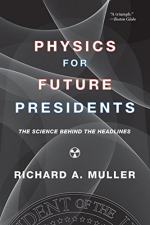
|
| Name: _________________________ | Period: ___________________ |
This test consists of 15 multiple choice questions and 5 short answer questions.
Multiple Choice Questions
1. In Section V, how many degrees Fahrenheit does the author say that the Earth's temperature has increased in the last century?
(a) 2.
(b) 5.
(c) 3.
(d) 4.
2. At what altitude in Chapter 15 would a geostationary Earth orbit satellite orbit the earth?
(a) 22,000 miles.
(b) 31,000 miles.
(c) 27,000 miles.
(d) 33,000 miles.
3. How how long could the lasers mentioned in Chapter 14 deliver a power of 500 trillion watts?
(a) 5 nanoseconds.
(b) 4 nanoseconds.
(c) 1 nanosecond.
(d) 6 nanoseconds.
4. How many tons of high-level nuclear waste were the underground tunnels at Yucca Mountain designed to hold?
(a) 77,000 tons.
(b) 45,000 tons.
(c) 92,000 tons.
(d) 110,000 tons.
5. How long do the carcinogens from coal-buring plants last in the ground?
(a) 500 years.
(b) Forever.
(c) 100 years.
(d) 50 years.
6. When did the U.S. and Russia sign a treaty where they promised to reduce their stockpile of nuclear weapons to less than 6,000 each?
(a) 1991.
(b) 1992.
(c) 1996.
(d) 1998.
7. When were high sea surface temperatures in the Caribbean detected by infrared satellites in Chapter 18?
(a) 2006.
(b) 2003.
(c) 2005.
(d) 2004.
8. In 2008, how much of the electricity generated in the United States came from nuclear power plants?
(a) 25%.
(b) 30%.
(c) 20%.
(d) 15%.
9. How long did the author believe it would take for a true power tokamak to become a reality in Chapter 14?
(a) About 50 years.
(b) 75 years.
(c) At least 20 years.
(d) 100 years.
10. When was it discovered that the amount of ozone formed in Antarctica was decreasing yearly?
(a) 1960s.
(b) 1950s.
(c) 1970s.
(d) 1980s.
11. In Chapter 15, how many satellites did the author state would be needed to view the entire globe continuously?
(a) 3,000.
(b) About 5,000.
(c) Around 6,500.
(d) 4,500.
12. When did the United States go after Osama bin Laden in the Tora Bora mountains of Afghanistan?
(a) 2001.
(b) 2000.
(c) 2003.
(d) 2002.
13. Where is much of the uranium obtained?
(a) Arizona.
(b) New Mexico.
(c) Colorado.
(d) Wyoming.
14. When did a pebble bed reactor have to be shut down in Germany?
(a) 2000.
(b) 1986.
(c) 1988.
(d) 2002.
15. In Chapter 14, where was a very large tokamak being built?
(a) Italy.
(b) France.
(c) Germany.
(d) Russia.
Short Answer Questions
1. In Chapter 11, when did the U.S. and Russia disclosed the number of nuclear strategic warheads that they had?
2. At 100 miles altitude, what percent is the gravity from what it is on the surface?
3. How much did it cost to launch a pound of anything into orbit in 2008?
4. When did Stanley Pons and Martin Fleischmann mistakenly believe they had achieved cold fusion?
5. In Chapter 13, where was there a prototype nuclear waste facility?
|
This section contains 351 words (approx. 2 pages at 300 words per page) |

|




